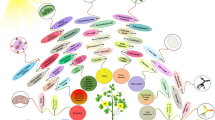Abstract
Ancestors of commercial cotton varieties are of tropical origin and are naturally adapted to growth in warm environments. Today, the derived cultivars retain the high optimal temperatures for growth that are characteristic of their progenitors. It is valuable to review the reported optimal temperature(s) for cotton before examining plant responses to temperature extremes. Despite many studies evaluating cotton temperature responses during the past century, a clear picture has yet to emerge whether there is a single temperature optimum for cotton metabolism. Some reports suggest distinct temperature responses within different anatomical structures, or at diverse developmental times. Discrepancies between reported temperature responses can be related to the measure of temperature itself. Some studies describing optimal temperatures for cotton refer to air temperature, while others refer to plant temperature. The discussion below will show that air and plant temperature measurements cannot be used interchangeably. This chapter will provide brief overviews of temperature measurement techniques, reported temperature optima, and the effects of low and high temperature stresses on cotton metabolism.
Access this chapter
Tax calculation will be finalised at checkout
Purchases are for personal use only
Preview
Unable to display preview. Download preview PDF.
Similar content being viewed by others
Bibliography
Arndt, C.H. 1945. Temperature-growth relations of the roots and hypocotyls of cotton seedlings. Plant Physiol. 20:200-219.
Balls, W.L. 1919b. The existence of daily growth-rings in the cell wall of cotton hairs. Proc. R. Soc. Lond. B. Biol. Sci. 90:542-555.
Bland, W.L. 1993. Cotton and soybean root system growth in three soil temperature regimes. Agron. J. 85:906-911.
Bradow, J.M. 1991. Cotton cultivar responses to suboptimal postemergent temperatures. Crop Sci. 31:1595-1599.
Burke, J.J. 1990. Variation among species in the temperature dependence of the reappearance of variable fluorescence following illumination. Plant Physiol. 93:652-656.
Burke, J.J. and D.R. Upchurch. 1995. Cotton rooting patterns in relation to soil temperatures and the thermal kinetic window. Agron J. 87:1210-1216.
Christiansen, M.N. 1963 Influence of chilling upon seedling development of cotton. Plant Physiology 38:520-522.
Christiansen, M.N. 1967. Periods of sensitivity to chilling in germinating cotton. Plant Physiology 42:431-433.
Christiansen, M.N. 1968. Induction and prevention of chilling injury to radicle tips of imbibing cottonseed. Plant Physiology 43:743-746.
Christiansen, M.N. and R.A. Rowland. 1986. Germination and stand establishment. pp. 535-541. In: Mauney, J.R., and J. McD. Stewart (eds.), Cotton Physiology. The Cotton Foundation, Memphis, Tenn.
Christiansen, M.N. and R.O. Thomas. 1969. Season-long effects of chilling treatments applied to germinating cottonseed. Crop Science 9:672-673.
Cole, D.F. and J.E. Wheeler. 1974. Effect of pregermination treatments on germination and growth of cottonseed at suboptimal temperatures. Crop Sci. 14:451-454.
Doorenbos, J. 1976. Agrometeorolgical-field stations. Irrigation and Drainage Paper no. 27, FAO, United Nations, Rome, Italy. 94 pp.
Fowler, J.L. 1979. Laboratory and field response of preconditioned upland cottonseed to minimal germination temperatures. Agron J. 71:223-228.
Fuchs, M. 1990. Infrared measurement of canopy temperature and detection of water stress. Theor. Appl. Climatol. 42: 253-261.
Gipson, J.R. and H.E. Joham. 1969. Influence of night temperature on growth and development of cotton (Gossypium hirsutum L.). III. Fiber elongation. Crop Sci. 9:127-129.
Gipson, J.R. and L.L. Ray. 1969a. Fiber elongation rates in five varieties of cotton (Gossypium hirsutum L.) as influenced by night temperature. Crop Sci. 9:339-341.
Guinn, G. 1971 Chilling injury in cotton seedlings: Changes in permiability of cotyledons. Crop Sci. 11:101-102.
Hawkins, R.S. 1930. Development of cotton fibers in the Pima and Acala varieties. J. Agric. Res. 40:1017-1029.
Hoffman, G.J. and S.I. Rawlins. 1970. Infertility of cotton flowers at both high and low relative humidities. Crop Sci. 10:721-723.
Kaspar, T.C. and W.L. Bland. 1992. Soil temperature and root growth. Soil Sci. 145:290-299.
Kerr, T. 1936. The structure of growth rings in the secondary wall of the cotton hair. Protoplasma 27:229-243.
Ludwig, C.A. 1932. Germination of cottonseed at low temperatures. J. Agr. Res. 44:367-380.
McMichael, B.L. and J.J. Burke. 1994. Metabolic activity of cotton roots in response to temperature. Environ. Expl. Bot. 34:201-206.
Muller, E. 1968. Getting a stand. pp. 6-7. In: Proc. West. Cotton Prod. Res. Conf., Cotton Council, Memphis, Tenn.
St. John, J.B. and M.N. Christiansen. 1976. Inhibition of linolenic acid synthesis and modification of chilling resistance in cotton seedlings. Plant Physiology 57:257-259.
Somero, G.N. and P.S. Low. 1976. Temperature: A “shaping force” in protein evolution. Biochem. Soc. Symp. 41:33-42.
Steiner, J.J. and T.A. Jacobsen. 1992. Time of planting and diurnal soil temperature effects of cotton seedling field emergence and rate of development. Crop Sci. 32:238-244.
Teeri, J.A. and M.M. Peet. 1978. Adaptation of malate dehydrogenase to environmental temperature variability in two populations of Potentilla glandulosa Lindl. Oecologia 34:133-141.
Thomas, R.O. and M.N. Christiansen. 1971. Seed hydration- chilling treatment effects on germination and subsequent growth and fruiting of cotton. Crop Science 11:454-456.
Wanjura, D.F. and D.R. Buxton. 1972b. Water uptake and radicle emergence of cottonseed as affected by soil moisture and temperature. Agron. J. 64:427-431.
Wanjura, D.F. and E.B. Minton. 1981. Delayed emergence and temperature influences on cotton seedling vigor. Agron J. 73:594-597.
Warner, D.A. and J.J. Burke. 1993. Cool night temperatures alter leaf starch and photosystem II: Chlorophyll fluorescence in cotton. Agron. J. 85:836-840.
Author information
Authors and Affiliations
Editor information
Editors and Affiliations
Rights and permissions
Copyright information
© 2010 Springer Science+Business Media B.V.
About this chapter
Cite this chapter
Burke, J.J., Wanjura, D.F. (2010). Plant Responses to Temperature Extremes. In: Stewart, J.M., Oosterhuis, D.M., Heitholt, J.J., Mauney, J.R. (eds) Physiology of Cotton. Springer, Dordrecht. https://doi.org/10.1007/978-90-481-3195-2_12
Download citation
DOI: https://doi.org/10.1007/978-90-481-3195-2_12
Publisher Name: Springer, Dordrecht
Print ISBN: 978-90-481-3194-5
Online ISBN: 978-90-481-3195-2
eBook Packages: Biomedical and Life SciencesBiomedical and Life Sciences (R0)




